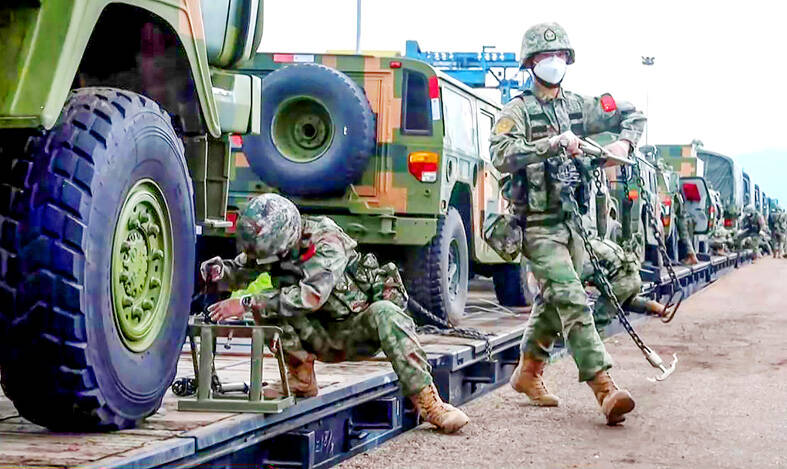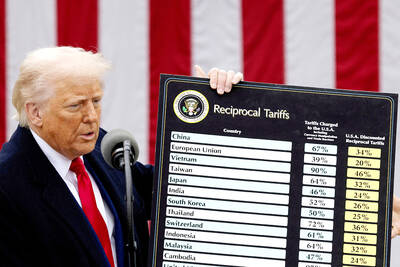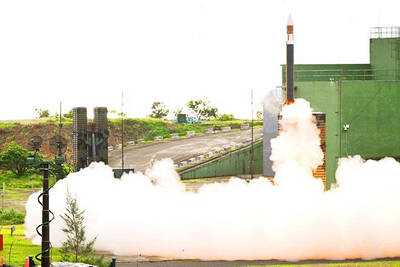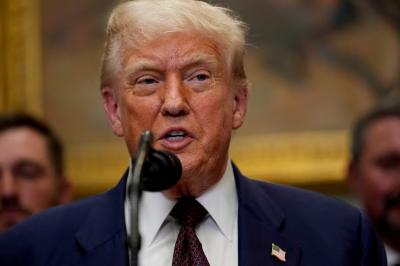Russian military exercises in the Far East this week are to take place on a far smaller scale than when they were last held in 2018, reflecting the strain on Moscow’s forces as they struggle to make headway on the battlefields of eastern Ukraine.
Announcing the “Vostok 2022” war games, in which China would also participate, the Russian Ministry of Defense last month said that its capacity to stage such exercises was in no way affected by what Russia calls its “special military operation” in Ukraine, but the 50,000 personnel that Moscow yesterday said would take part are a fraction of the official figure of 300,000 that were said to be involved four years ago — although some Western military analysts suspect that number was overstated.
The ministry said that 140 military aircraft and more than 5,000 items of military hardware would be deployed — way down on the 1,000 aircraft and 36,000 tanks and armored vehicles that were reported to have been sent to the 2018 maneuvers.

Photo: AFP / Russian Ministry of Defense
“This is going to be the smallest strategic-level exercise in years because the entire ground forces potential is engaged in operations in Ukraine. So the exercise will have to be very small,” said Konrad Muzyka, director of Rochan military consultancy based in Poland.
The exercises would be closely watched by regional powers such as Japan and South Korea as a significant show of force by Russia and China, which joined up in Vostok 2018 and are to take part again in drills on land and at sea.
Russia said its Pacific Fleet and China’s navy would take part in “joint practical actions to defend maritime communications and areas of maritime economic activity” in the Sea of Japan.
Russia’s armed forces news channel Zvezda yesterday posted a video of Chinese troops unloading armored vehicles delivered to Russia by rail.
Muzyka said he estimated that 70 to 80 percent of units from Russia’s eastern military district had been deployed to Ukraine, making it “impossible” for Moscow to free up 50,000 men for exercises. He said a more plausible figure would be 10,000 to 15,000.
“It’s just Russia pretending everything is fine and they still have the capability to launch a large-scale military exercise with China, but in reality I think the scope of this exercise, especially from a ground force perspective, is going to be very, very limited,” he said.

WAITING GAME: The US has so far only offered a ‘best rate tariff,’ which officials assume is about 15 percent, the same as Japan, a person familiar with the matter said Taiwan and the US have completed “technical consultations” regarding tariffs and a finalized rate is expected to be released soon, Executive Yuan spokeswoman Michelle Lee (李慧芝) told a news conference yesterday, as a 90-day pause on US President Donald Trump’s “reciprocal” tariffs is set to expire today. The two countries have reached a “certain degree of consensus” on issues such as tariffs, nontariff trade barriers, trade facilitation, supply chain resilience and economic security, Lee said. They also discussed opportunities for cooperation, investment and procurement, she said. A joint statement is still being negotiated and would be released once the US government has made

NEW GEAR: On top of the new Tien Kung IV air defense missiles, the military is expected to place orders for a new combat vehicle next year for delivery in 2028 Mass production of Tien Kung IV (Sky Bow IV) missiles is expected to start next year, with plans to order 122 pods, the Ministry of National Defense’s (MND) latest list of regulated military material showed. The document said that the armed forces would obtain 46 pods of the air defense missiles next year and 76 pods the year after that. The Tien Kung IV is designed to intercept cruise missiles and ballistic missiles to an altitude of 70km, compared with the 60km maximum altitude achieved by the Missile Segment Enhancement variant of PAC-3 systems. A defense source said yesterday that the number of

‘CRUDE’: The potential countermeasure is in response to South Africa renaming Taiwan’s representative offices and the insistence that it move out of Pretoria Taiwan is considering banning exports of semiconductors to South Africa after the latter unilaterally downgraded and changed the names of Taiwan’s two representative offices, the Ministry of Foreign Affairs (MOFA) said yesterday. On Monday last week, the South African Department of International Relations and Cooperation unilaterally released a statement saying that, as of April 1, the Taipei Liaison Offices in Pretoria and Cape Town had been renamed the “Taipei Commercial Office in Johannesburg” and the “Taipei Commercial Office in Cape Town.” Citing UN General Assembly Resolution 2758, it said that South Africa “recognizes the People’s Republic of China (PRC) as the sole

Taiwanese exports to the US are to be subject to a 20 percent tariff starting on Thursday next week, according to an executive order signed by US President Donald Trump yesterday. The 20 percent levy was the same as the tariffs imposed on Vietnam, Sri Lanka and Bangladesh by Trump. It was higher than the tariffs imposed on Japan, South Korea and the EU (15 percent), as well as those on the Philippines (19 percent). A Taiwan official with knowledge of the matter said it is a "phased" tariff rate, and negotiations would continue. "Once negotiations conclude, Taiwan will obtain a better